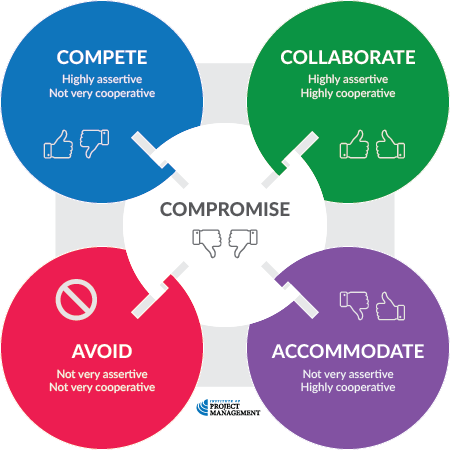Resolution criteria
As important as it is to be heard, people want conflict resolved (usually in their favor); therefore, you will need to make a decision.
Yet, not all conflict can be resolved in a single session, so an interim action might be to consult with others to gather more information before meeting again at a scheduled time.
Similarly, not all conflicts can be resolved by you, so your decision may be to escalate the matter to a higher authority or professional mediation.
No matter what, though, you need to show progress at every stage, and a number of factors may determine how you respond, including:
- The relative importance and intensity of the conflict
- The time pressure for resolving the conflict
- The position taken by players involved
- The availability of resources
- The motivation of parties to resolve conflict on a long-term or short-term basis, and
- The relative power and interest of stakeholders – remember that from Unit 2?
Thomas-Kilmann model
In the 1970s, Kenneth Thomas and Ralph Kilmann identified five main approaches to dealing with conflict that vary in their degrees of cooperativeness and assertiveness.
They argued that people typically have a preferred conflict resolution style that is a function of the extent to which they are both assertive and cooperative.
Once you understand the different styles, you can use them to think about the most appropriate approach (or mixture of approaches) for the situation you’re in.
You can also think about your own instinctive approach and learn how you need to change this if necessary.

Avoid
Avoiders tend to pretend the conflict does not exist.
This style is typified by delegating controversial decisions, accepting default positions, and not wanting to hurt anyone’s feelings.
It can be appropriate when victory is impossible; when the controversy is trivial; or when someone else is in a better position to solve the problem.
However, for the project manager – who we know is expected to be a decision-maker – avoiding is, in many situations, a weak and ineffective response.
Accommodate
Accommodating indicates a willingness to meet the needs of others at the expense of the person’s own needs.
The accommodator often knows when to give in to others, but can be persuaded to surrender a position even when it is not warranted.
Accommodation is appropriate when the issues matter more to the other party, when peace is more valuable than winning, or when you want to be in a position to collect on this ‘favor’ you gave.
However, people may not return favors, and this approach is unlikely to give the best outcomes to the accommodator.
Compete
People who tend towards a competitive style take a firm stand and know what they want.
They usually operate from a position of power, drawn from things like position, rank, expertise, or persuasive ability.
This style can be useful when decisions need to be made fast (as is often the case in projects); when the decision is unpopular; or when defending against someone who is trying to exploit the situation selfishly.
However, it can leave people feeling bruised, unsatisfied, and resentful when used in less urgent situations.
Collaborate
People tending towards a collaborative style try to meet the needs of all people involved.
These people can be highly assertive but, unlike the competitor, they cooperate effectively and acknowledge that everyone is important.
This style is useful when you need to bring together a variety of viewpoints to get the best solution, when there have been previous conflicts in the group, or when the situation is too important for a simple trade-off.
Despite being seen as a win-win, true collaboration takes much more time to achieve than the other responses, which is often at odds with the scheduling constraints of project delivery.
Collaboration should therefore be reserved for those conflicts where the win-win outcomes are worth these investment costs; ideally at the start of the project when the cost of change is low.
Compromise
People who prefer a compromising style try to find a solution that will at least partially satisfy everyone.
Everyone is expected to give up something, and the compromiser also expects to relinquish something.
Compromise is useful when the cost of conflict is higher than the cost of losing ground, when equal-strength opponents are at a standstill, and when there is a deadline looming.
However, it may come at the cost of ‘dumbing down’ ideas.
*Note: The two thumbs down in this graphic illustrate both parties giving something up – it does not imply compromise is a bad thing!
Ideally, you should adopt an approach that meets the needs of the situation, resolves the problem, respects people’s legitimate interests and mends damaged working relationships.




